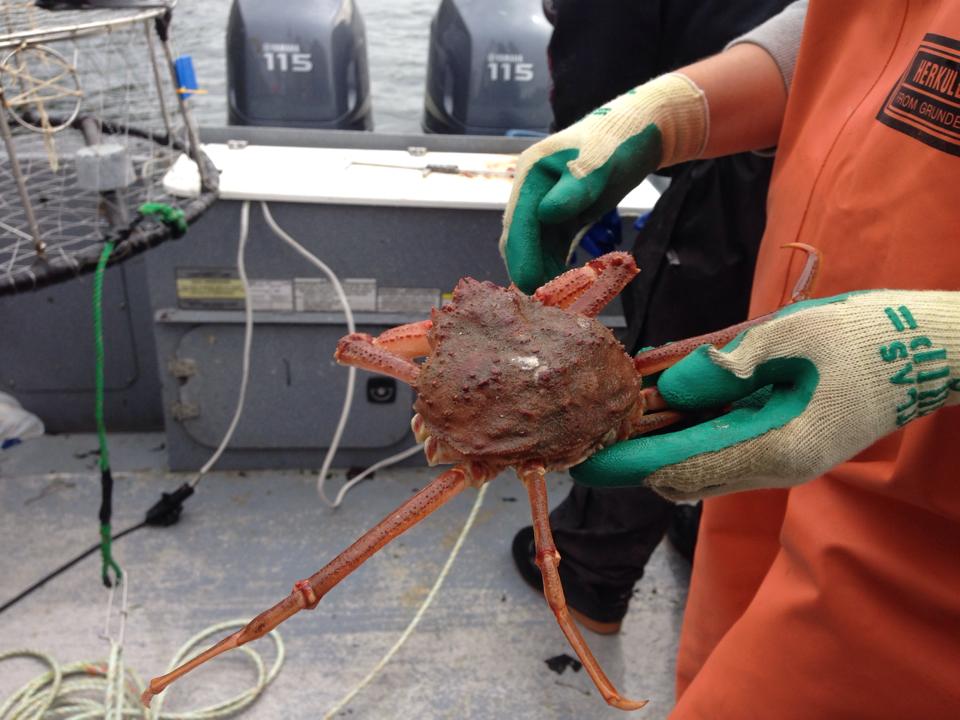After several years of coordinated research and surveying crab populations, Central Coast Nations build the case for preserving this culturally significant food source.
Coastal First Nations have long enjoyed the bounty of Dungeness crab – not just as a source of food, but for use in many social and cultural practices as well, including potlatch ceremonies.
Harvesting crab for these traditional uses is a constitutionally protected Aboriginal right – what is known as the right to fish for food, social and ceremonial (FSC) purposes. If crab populations are threatened by over-fishing or other factors, affected Nations are not about to sit back and do nothing.
In 2007, as evidence mounted of depleted crab populations in their territories, Central Coast First Nations brought their concerns to Fisheries and Oceans Canada (DFO) and asked for closures of the commercial fishery – a complaint that was initially met with demands for proof. Now, after a coordinated research effort from the Heiltsuk, Kitasoo/Xai’Xais, Nuxalk and Wuikinuxv Nations, which involved extensive surveys throughout the Central Coast using DFO protocols, those earlier claims have been borne out: commercial and recreational fisheries are depleting local crab stocks and negatively affecting FSC fisheries.
“Basically, the Nations are using technical scientific work to support what they already know,” says ecologist Alejandro Frid, who helped coordinate the research project for the Central Coast Indigenous Resource Alliance (CCIRA). “This research is about combining local, traditional knowledge and science together; it’s really the interface of those two things.”
The study involved closing several sites to commercial and recreational fisheries – doing so under Indigenous Law – while leaving an equal number of ecologically similar areas open to all fisheries, so that stewardship staff and researchers could monitor the difference. The surveying work was carried out by Coastal Guardian Watchmen from participating Nations, who found that legal-sized crabs – i.e. large males targeted by fisheries – became more abundant in the closed sites than in the open sites.
Those results, published in the scientific journal Global Ecology and Conservation, offered clear proof that commercial and recreational fisheries were negatively affecting local crab populations. However, DFO wanted further proof that this was specifically affecting availability of crabs for FSC purposes. That prompted another study, to be released this year, which gathered first-hand knowledge from Indigenous Elders describing how local crab populations had changed over time.
“The researchers interviewed Elders who’d been fishing for decades, in some cases 50 to 60 years,” says Frid, which helped the research team sketch out typical expectations of a successful crabbing trip for FSC purposes, and allowed them to construct a timeline for changes in crab abundance throughout the region. “We did some computer analysis on prior data,” he adds, “and found that of all places we’d surveyed, only one had a high chance of a successful FSC trip.”
Taken together, these studies provide grounds for action on preserving healthy crab populations in the region, but they also offer a glimpse into how important coordinated marine management can be.
“The information we’re collecting about the crab fishery will be really valuable over time,” says Ernie Tallio, a Nuxalk Guardian Watchmen who’s helped with crab research since 2011. With Nuxalk surveys beginning again this spring, Tallio says they’re meeting with local crabbers to provide updates on the research and fishery closures. Although he says most fishers have respected the closures in past years, some have not – an issue that’s been exasperated by a lack of support or enforcement by DFO.
For Tallio, the research has been an eye-opener regarding the extent of impacts from both commercial and recreational crab fishing in his territory. “We started in the Bella Coola Estuary,” he recalls. “We noticed after commercial crabbers came to drop pots, and especially after the commercial gill-net fleets came in the summer, it would really deplete the population. It makes it a lot harder for local Nuxalk to get any legal-sized crab.”
Tallio says recreational fishing has huge effects as well, and describes a crab survey they conducted in the South Bentinck Arm after a logging float camp had been there for while. “In our first survey in 2011, every pot was full and we were catching all kinds of large crabs,” he says. “We did another survey in 2014, and they were almost all gone. They’re just starting to come back now. I don’t how many crew members were in that camp but they sure did a number on the crab population.”
With all four Nations working to align crab research in terms of protocols and techniques, it’s a great collaborative exercise on the Central Coast – one that will not only help sustain crab populations, but could lead to better working relationships with other government agencies as well. “So yeah,” says Tallio, “it’s pretty important to us.”


